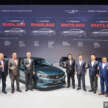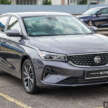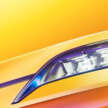The 2024 Proton S70 is now officially launched, earlier than the expected December date. Unlike previous Geely-Proton models, the gestation period for the new sedan was pretty short. First official details and images surfaced on November 1, and the media preview happened shortly after that. From that session, we gave you all you needed to know about the S70 except for the price, so here we go.
The Proton S70 comes in four variants, and they are the Executive, Premium, Flagship and Flagship X (Standard variant name dropped). The entry-level Executive kicks off the range at RM73,800, while the Premium sells for RM79,800. For many, the Flagship is where the S70 range truly starts, and it’s yours for RM89,800. If you want a sunroof, dashcam and the exclusive Quartz Black paint, the Flagship X is priced at RM94,800. All are on-the-road without insurance.
As expected, the S70’s price range puts in right smack in Honda City and Toyota Vios territory, and those two are household names in the B-segment sedan market. But Proton is calling the S70 a C-segment sedan, with a ’70’ badge to match. By the way, if you want to jump straight to the specs, we’ve listed it all down in point form – scroll down.
The Great Debate
So, is the S70 a B- or C-segment sedan? Well, it’s based on the Geely Emgrand, which sits on the X50’s BMA platform, and the car has a 1.5 litre NA engine/CVT combo elsewhere – 1.5L CVT is of course the ASEAN B-segment default set by the Toyota Vios and Honda City.
In fact, everyone thought that car codenamed SS11 would be called ‘Proton S50’ till we saw spyshots of the S70 badge last month. The pricing of the S70 is also squarely within the City-Vios space, and the two class stalwarts were chosen as rivals in the media preview acceleration test.
It’s a B then. But Proton complicates things (by design, I’m sure) by giving the sedan the ’70’ name. Officially, Proton is calling this a C-segment sedan, and ’70’ ties in with the X70, a C-SUV. The carmaker has also plonked in a 1.5 litre turbo engine and dual-clutch gearbox in place of the 1.5L NA CVT that powers the Emgrand in China and the Philippines. Think 1.5T, think Honda Civic, right?
What about dimensions? Glad you asked. According to the brochure, the S70 is 4,602 mm long and 1,809 mm wide, with a 2,627 mm wheelbase. Strangely, these are lower than the Emgrand’s numbers. Based on Proton’s figures, the S70 is just 13 mm longer than the Honda City RS and 61 mm wider, with a wheelbase that’s 27 mm longer. The S70 is longer and wider than the Preve and Mitsubishi Lancer-based Inspira, Proton’s previous two C-segment sedans. Speaking of those models, Proton says that the S70 follows the lineage of the Wira, Waja and Preve.
It’s a C then. But cars grow in size, and a Civic then isn’t the same as a Civic now. On that note, today’s Civic FE is 76 mm longer than the S70, and the Honda’s 2,735 mm wheelbase is a whopping 108 mm longer. In fact, going by the numbers, the S70 is actually closer to the City than the Civic in size. And all of the Civic, Toyota Corolla and Mazda 3 are also lower slung than the S70, giving them sportier proportions that are more inline with the C-segment.
We’ll leave it up to you to place the S70, as it’s a bit of a mishmash. Outside of car guy circles, Proton calling their new sedan C-segment will enable salesmen to use the “Civic rival at City price” good value pitch, just like what they did with the X70 (CR-V size and specs at HR-V price).
Turbo-DCT from X50
The S70 gets turbo power instead of the Emgrand’s standard 1.5L NA unit, and the turbo engine in question is the 1.5-litre port-injected three-cylinder engine that powers the X50 Standard to Premium, and not the 177 PS/255 Nm 1.5L TGDi unit in the X50 Flagship and X70 MC. Like in the non-Flagship X50, the 1.5L MPI unit’s output is 150 PS and 226 Nm of torque from 1,750 to 4,000 rpm in the S70. Why no 1.5 NA or TGDi? Proton’s answer here.
For those keeping count, the Civic’s 1.5-litre four-cylinder VTEC turbo engine makes 182 PS and 240 Nm, which is 32 PS and 14 Nm more than the S70. As for the NA B-segment duo, the City has 121 PS/145 Nm (S70 +29 PS, +81 Nm) and the Vios’ 2NR-VE has 106 PS/138 Nm (S70 +44 PS, +88 Nm). Proton claims 0-100 km/h in around nine seconds.
Besides the point that a turbo engine would make the S70 a more convincing C-segment sedan, it also makes perfect business sense for Proton as the engine is already made in Tanjong Malim for the X50, while Geely’s 1.5L NA is not used in any current Proton. Using the engine in two models gives Proton better economies of scale, and in this case, the consumer benefits too. Ditto the seven-speed wet-clutch DCT.
Local input, deluxe Emgrand
In the switch from left- to right-hand drive (steering now perfectly centred in front of the driver by the way, no longer offset like in X50/X70), the S70 project saw the development of 453 new parts with the involvement of 283 local suppliers, Proton says. The sedan has 145 knocked down (KD) parts and 24 in-house Proton developed parts. Of course, the engine is made in Malaysia. A total of 260,000 man hours were utilised.
Still, the target is to reach 70% local content in a couple of years, deputy CEO Roslan Abdullah revealed at the media preview. That’s nowhere near the over 90% local content of Perodua models from launch, and non-national models probably source more from Malaysia. This is not of concern to the customer, of course, and we only spotted one Geely logo on the fleet of pre-production cars – on the sunroof.
The most obvious change from the Emgrand is the S70’s grille, which combines the ‘Infinite Weave’ and ‘Ethereal Bow’ cues from past Geely-Protons to form an elaborate yet neat grille with pins. The side edges of the grille are blacked out to emphasise the Ethereal Bow (lower border), and Proton’s new round tiger badge floats in the middle. To us, it’s a handsome face and one that’s much better looking than the Emgrand, which has vertical lines in its grille.
Everything else is as per the Geely, including G20 BMW 3 Series-style ‘side intakes’, the two-tone 17-inch wheels, the slightly jarring protrusion of chrome from the A pillars and the fancy rear LED full-width signatures.
Speaking of the rear lights, they perform a show when you unlock the car and appear to be naturally ‘smoked’ even in daylight. We’re also wondering why the smart entry button on the driver’s door handle is in chrome, and not hidden away in body colour. There’s no button on the passenger side by the way, and it’s a downgrade from the touch sensor on Proton’s SUVs.
If the exterior is largely Emgrand bar the grille and rear Proton badge, the interior is a deluxe version of the sedan compared to what’s available in the Philippines, and to a lesser degree, China. The default gear lever is a conventional tall stick, but Proton is offering the stubby ‘T-design’ electronic shifter from the X90, which looks way more advanced and premium.
More parts sharing with existing Protons (which are not from the original Emgrand) can be seen in the steering wheel from the X50. Also, the sedan’s cabin is peppered with a soft material that has a songket-inspired pattern. You can find this S70-exclusive trim on the dashboard and door armrests – it’s a nice touch.
The most important aspect of the local input is none other than the well-regarded ‘Proton ride and handling’. The carmaker says that the S70 is tuned for Malaysian roads and the R&D team spent 75,000 man hours and drove a combined 1.2 million km of development miles. Typically, Chinese cars are softly sprung and comfort-oriented to suit the local palate, but Malaysians drive faster and require more control, more dynamics. With regards to ride and handling, Proton engineers claim that they managed to improved both comfort and stability.
However, Proton stoped short of changing the Emgrand’s rear suspension from a torsion beam to multi-links like they did with the X90. Independent rear suspension is a norm in the C-segment, whereas the City/Vios have a torsion beam. They did however upgrade the size of the front brakes to match the heavier turbo engine.
Lots of kit, at the top
The S70 will come in four variants, but we’ll call it ‘3+’. Unlike the X50, there’s no Standard variant, and the sedan’s range starts from Executive. The mid-level spec is Premium and the top one is the Flagship. The Flagship X makes it four, but the only difference the ‘X’ brings is a sunroof and an exclusive Quartz Black paint option.
Is the S70 well equipped? Yes, but the entry-level Executive is bound to look vastly different from the Flagship/Flagship X cars that were on duty at the media preview. Much of the exterior and interior bits that make the S70 look fancy (LED headlamps, rear LED signatures, 17-inch wheels that look just about large enough, digital meter panel, infotainment touchscreen) are not present in the Executive. A low entry price gets more eyeballs. Some would say that the Exec’s kit list is more ‘Standard’.
All variants have the same 1.5T 7DCT powertrain, six airbags, lane change assist and an electronic parking brake with auto hold. The Executive comes with fabric seats, halogen headlamps, 16-inch wheels and an 8.0-inch head unit. To get LED headlamps (projectors) and tail lamps, you’ll have to buy the Premium, which also adds on leatherette upholstery, auto air-con and a reverse camera.
LED headlamps have been standard on the Perodua Myvi since 2017, and even a RM40k Axia gets them, so the base S70 is nowhere near C-segment in terms of equipment. We’ll see what the price gap is between variants, but it looks like the Premium is where the range truly starts. Even so, there’s no full ADAS and AEB at the midpoint – Lane Change Assist (blind spot warning), Door Opening Warning, Rear Collision Warning and Rear Cross Traffic Alert are standard across the board.
Proton is once again reserving the full driver assist pack for the Flagship. The comprehensive ADAS suite adds on Autonomous Emergency Braking with Forward Collision Warning, Adaptive Cruise Control with Stop & Go, Lane Departure Warning and Prevention, Lane Centring Control, Traffic Sign Information and Intelligent High Beam Control. By the way, ADAS is not available on the Emgrand, so this is yet another Proton-exclusive feature. Five stars in the ASEAN NCAP crash test, by the way.
The Flagship also gets a tyre pressure monitoring system, the 17-inch two-tone alloys you see here, the cockpit’s dual screen setup (10.3-inch meter, 12.3-inch infotainment with Hi Proton), wireless charger, powered driver’s seat (none of the B-segment players have this) and 360-degree camera with 3D display.
As mentioned, the Premium X’s only extra pieces of kit are the sunroof and dashcam, but the range topper does get an exclusive Quartz Black paint option. Black isn’t a common colour for Protons – will this car be supplied to the government? The Flagship X can also be had in Snow White, Space Grey, Marine Blue and Teal Bayou Green – the latter is a new-to-Proton colour inspired by our tropical beaches.
The signature green and Marine Blue, which are the colours you see in the studio pics here, are reserved for the Flagship and above. The dark blue car has a five-piece bodykit consisting of a front lip, side skirts, rear bumper extension and a boot spoiler. Proton did not mention the bodykit in its presentation though, so we’ll have to wait for more details. No R3 logos on the kit, by the way.
There’s always a different kind of buzz when we’re seeing a Proton/Perodua for the first time. More anticipation and more pressure too, because it seems like national cars are well, of national interest – everyone talks about it, everybody wants to know about it, not just car people. We genuinely want to see the cars do well, but also have the duty to report as it is.
Kudos to Proton for having a couple of cars that it sees as the S70’s rivals at the preview. So confident they are that it wasn’t just the Vios and City present – we were all shocked to see the BMW 2 Series Gran Coupe and Mercedes-Benz A-Class Sedan parked alongside for static comparison. Surely not ‘Asia’s answer to BMW’ all over again? More on that later.
Our first impression of the S70 is a good one. This is a three-box sedan that’s handsome in a slightly old school way, and it reminds me of the third-generation Subaru Legacy (B4 RSK!). Proton might have just changed the grille of the Emgrand, but it’s a change for the better – the S70 looks more premium than the Geely. SUVs rule the market these days, but many guys still like sedans, and we think that the S70 will capture the imagination of many bros out there.
Step in and you’re greeted by a throughly contemporary cockpit with three of the most popular elements checked – horizontal dash layout (always emphasised by full-width look AC vents), a high centre console, and two screens (meter and central). The latter gives off a high-tech, advanced feel that goes well with (and is integral to) the minimalist design. Plenty of X90 elements, but the S70’s cockpit is way more stylish.
Look closer and you’ll find a delightful local touch – the passenger-facing piece of trim below the AC vents is soft to the touch and has a nice songket-inspired pattern. This material is repeated on the door armrests. This and the dash top both pass the knock-knock Malaysian showroom test – the dash top, which has stitching on the edge, feels solid. Also nice is the stitched pattern on the door cards, which reminds me of Asics’ Tiger Stripes.
This positive feel doesn’t flow into the centre console and doors; the latter is covered in scratchy hard plastic and the door handles, while nicely integrated design-wise, has a lacquer-like silver finish that feels cheap. So, overall perceived quality is a mixed bag, and sitting in the BMW 2GC after the S70 merely emphasised the gulf in premiumness.
To be fair, hard plastics are common in the B-segment, which the S70 will be priced against. But it’s Proton who’s calling it a C (Civic cabin feels more premium in touch and feel) and brought a BMW along. As mentioned, we like the design and advanced feel, and the IP is quality.
At the media preview, we pushed the S70 along a short course in Proton’s Shah Alam proving ground and also had it in a drag race with the City and Vios. It didn’t take long to deduce that the S70 is tuned for comfort rather than sport, as a sub-RM100k family sedan should be – it’s easy to drive with light and smooth steering, and primary ride comfort should be good, based on its calm, composed reaction to a dip in the course.
We didn’t try the sedan on rough surfaces, but based on trend and Proton’s well-proven capabilities in ride and handling, the S70 should be a well-damped, forgiving ride. Expect some lean on steady-state cornering from this relatively tall sedan, but nothing too disconcerting.
It depends on what your expectations are, but if you hear 1.5T DCT and think ‘VW TSI DSG’ or ‘Civic-beater’, be prepared to be disappointed. There’s a significant delay between your right foot asking for full throttle and the powertrain getting the message, so much so that the City consistently beats the S70 off the line.
But give the Proton enough road and it will eventually overtake and pull away from the Honda, as it should, being turbocharged. The Vios? Quite a distance away from the other two, literally. Away from the drag strip’s standing start, the in-gear acceleration of a turbocharged car would be useful in cut and thrust daily driving.
Speaking of the daily grind, we noticed that the S70’s transmission swaps gears pretty leisurely for a dual-clutch unit, and its engine is more audible than the Vios at idle and low speeds, while sounding coarser. When it comes to isolation, Toyota is tops – even the previous-generation Vios/current Yaris is more refined on the move. Personally, I feel that the lack of powertrain refinement is at odds with the premium messaging.
Moving to the back seat, we can report that the bench is nicely shaped and the seat base height is sufficient. The length is of the seat base is just about right for my 175 cm frame. The S70’s rear headroom betters the City and Vios – it was my first time in the Toyota and I was shocked that they signed this off, and I’m not even that tall.
The most layman way of measuring rear space is legroom, and you’ll expect the ‘C-segment’ car to romp home. Instead, if stretching your rear legs is an important consideration, the City and Vios have more acreage. Mind you, the S70 isn’t cramped by any means, but rear legroom is short of the ASEAN B-segment’s abnormally high bar. Also, if the driver’s seat is set to the lowest position, there’s not much room under it for feet to tuck into.
Anyhow, it’s decent at the back, and passengers get to enjoy AC vents (they look strangely ‘naked’ though), a centre armrest, and two USB ports (1x A, 1x C). As with the front doors, there are stitched stripes on the door cards and songket-patterned soft material on the side armrests. Boot volume is 500 litres and there’s a space saver spare wheel under the floor.
So, how does the S70 compare with its rivals, you ask. The answer depends on who you consider its rivals to be, as discussed above in The Great Debate. Proton is calling the S70 a C-segment sedan, but truth be told, the Honda Civic has it easily beat in touch, feel, drive and desirability. As such, there’s no need to discuss the BMW 2GC.
Click to enlarge price list and early bird package list
However, the S70 is priced squarely in the City and Vios range. And against those two, there’s certainly a case for the Proton, which is plenty of car for the money – you’ll get a bigger body, a turbo engine, lots of toys and some feel-good features that are first-in-class such as electric seat adjustment. The S70 is a decent drive and it looks good in and out, too. However, there’s no Apple CarPlay and Android Auto support, not yet at least.
It must be noted though that much of the good stuff you see here are reserved for the Flagship. Also, Proton has announced a ‘standard package’ for the S70, which consists of a five-year unlimited mileage warranty, a five-year data package (1GB per month, only for the Flagship and above), six times free labour service and financing rates from 2.34%.
There’s more. The first 3,000 bookings will get the aerokit you see on the blue car here, worth RM3,130. That’s only for the Flagship X though – early birds for the other variants get RM500 service vouchers and upgraded Proton Insurance Programme. To enjoy the early bird perks, you must register your S70 by February 29, 2024.
For now, what do you think of the Proton S70 as it is, and vis-à-vis the Honda City and Toyota Vios? Check out the list of specs below and once you’re done, join Hafriz on a detailed video tour of the S70. We will have full galleries of all variants – stay tuned.
2024 Proton S70 Executive – RM73,800
Gets as standard:
Mechanicals
1.5 litre DOHC MPI turbocharged three-cylinder engine
150 PS at 5,500 rpm, 226 Nm at 1,750 to 4,000 rpm
7-speed wet dual-clutch automatic transmission with manual mode
Electric power steering (EPS)
Electronic parking brake with auto hold
MacPherson strut suspension (front), torsion beam (rear)
Ventilated disc brakes (front), solid discs (rear)
50-litre fuel tank
Exterior
Halogen headlamps
LED daytime running lights
16-inch two-tone alloy wheels with 205/55 Giti GitiComfort F22 tyres
Power adjustable side mirrors, manual fold
Interior
Smart entry with push-start button
Remote engine start
Cruise control
Drive mode selection – Eco, Comfort, Sport
Urethane steering wheel
Tilt and telescopic steering wheel adjustment
Steering wheel audio controls
8.0-inch touchscreen infotainment system with Bluetooth
Four speakers
5x USB ports – 3x front, 2x rear
Analogue meter panel
Manual air-conditioning with N95 cabin filter and rear vents
Fabric upholstery
Auto-down power windows – all
Safety
Six airbags (front, side, side curtain)
VSA, ABS, EBD, brake assist
Hill hold assist
Rear collision warning
Lane change assist
Rear cross traffic alert
Door opening warning
Reverse sensors, three-eye
2024 Proton S70 Premium – RM79,800
Adds on:
Exterior
Automatic LED headlamps
Rear LED light bar
Auto folding side mirrors
Interior
Leatherette steering wheel
Leatherette seats
Automatic air con, single-zone
Rear centre armrest
Anti-trap power windows
Safety
Reverse camera
Front parking sensors, two-eye
2024 Proton S70 Flagship – RM89,800
Adds on:
Exterior
17-inch two-tone alloy wheels with 205/50 Goodyear Assurance tyres
Auto nearby trunk unlock
Interior
Steering mode selection – Comfort, Normal, Sport
Full LCD digital meter panel
Security window tint
Powered driver’s seat, six-way
12.3-inch touchscreen infotainment system with 4G and WiFi
Voice command, navigation, music streaming, weather forecast
Proton Link app with vehicle status, remote control
Wireless charger
Six speakers
Safety
Autonomous emergency braking
Forward collision warning
Adaptive cruise control with stop and go
Intelligent cruise control
Lane departure warning
Lane departure prevention
Lane centering control
Traffic sign information
Auto high beam
Tyre pressure monitoring system
360-degree camera with 3D display
2024 Proton S70 Flagship X – RM94,800
Adds on:
Exterior
Sunroof
Safety
Front dashcam
GALLERY: Proton S70 1.5T Flagship X
GALLERY: Proton S70 1.5T Flagship
GALLERY: Proton S70 presentation
GALLERY: Proton S70 official images
The post Proton S70 sedan launched – Executive, Premium, Flagship, X; 1.5T 7DCT; City/Vios rival RM74k to RM95k appeared first on Paul Tan’s Automotive News.




